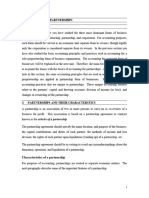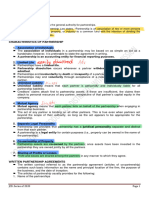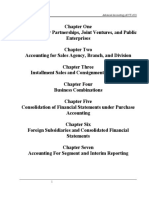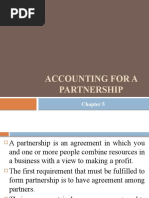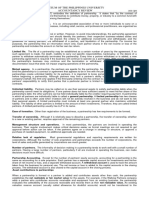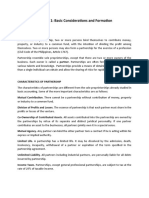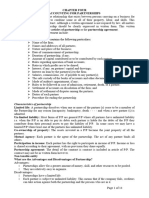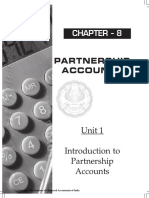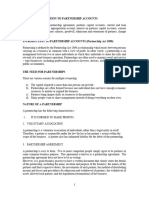Chapter 5
Chapter 5
Uploaded by
zeleke trumpCopyright:
Available Formats
Chapter 5
Chapter 5
Uploaded by
zeleke trumpCopyright
Available Formats
Share this document
Did you find this document useful?
Is this content inappropriate?
Copyright:
Available Formats
Chapter 5
Chapter 5
Uploaded by
zeleke trumpCopyright:
Available Formats
Fundamentals of Accounting II CHATER 5
Chapter Four
5. Accounting for Partnerships
5.1. Introduction
For accounting purposes, each form of business i.e. sole proprietorship, partnership, and corporation should be
viewed as an economic unit separate from its owners, though legally only the corporation is considered separate
from its owners. The main focus of this chapter is to acquaint with the basics of accounting for partnerships.
These unique accounting features relate to the partners’ capital and drawing accounts, division of income (or
loss), and changes in ownership of the partnership.
5.2. Partnership
A partnership is an association of two or more persons to carry-on as co-owners of a business for profit. This
association is based on a partnership agreement or contract known as the articles of a partnership.
partnership. The
partnership agreement should specify the name location, and purpose of the business; the capital contributions
and duties of each partner; the methods of income and loss division; the rights of each partner upon liquidation
(winding up) of a partnership, etc. The partnership agreement should be in writing to avoid any
misunderstandings about the formation, operation, and liquidation of a partnership.
5.3. Characteristics of a partnership
For purposes of accounting, partnerships are treated as separate economic entities. The next paragraphs describe
some of the important features of a partnership.
I. Association of Individuals
A partnership is a voluntary association of individuals rather than a legal entity in itself. Therefore, a partner is
responsible under the law for his or her partner’s business actions within the scope of the partnership. A partner
also has unlimited liability for the debts of the partnership. Because of these potential liabilities, an individual
must be allowed to choose the people who join the partnership. A partnership is legal entity for certain purposes
(i.e., property can be owned in the name of the partnership) accounting entity for financial reporting purposes
Net income of a partnership not taxed as a separate entity each partner’s share of income is taxable at personal
tax rates.
II. Limited Life
Because a partnership is formed by the consent of two or more partners, it has a limited life. This means that,
anything that ends the contract dissolves the partnership. A partnership can be dissolved when (1) a new partner
is admitted; (2) a partner withdraws, retires, dies or becomes bankrupt. At this point, the remaining partners
should sign a new contractual agreement to continue the affairs of the business. In place of the old partnership a
new partnership is formed. Thus, a partnership is said to have a limited life.
Accounting for Partnerships Page 1
Fundamentals of Accounting II CHATER 5
III. Unlimited Liability
Each partner is liable for all the debts of the partnership. When and if the partnership fails to pay its debts,
creditors can seize (take) each partner’s personal assets to satisfy their claims. Therefore, a partnership
creditors’ claims are not limited to the assets of the business, but is extends to the personal property of the
partners. Each partner, then, could be required by law to pay all the obligations (debts) of the partnership.
Suppose, for example, the liabilities of ABC company (a partnership business) as of a certain date is birr
600,000, however, the total properties (assets) of ABC company could only be sold for birr 450,000. Thus, to
settle creditors’ claims fully, the house or personal assets of the partners may have to be sold.
IV. Mutual Agency
Each partner is an agent of the partnership within the scope of the business. This means that partner’s act to any
contract is binding on the remaining partners as long as it is within the apparent scope of the business’
operations. For example, a partner in a public accounting firm can bind the partnership through the delivery of
accounting services. But this partner cannot bind the partnership to a contract for delivering (or providing) cars
because it is out of the scope of the business.
V. Co ownership of partnership property
Once invested, the properties contributed by the partners become the property of the partnership and is owned
jointly by all the partners. Upon liquidation of the partnership and distribution of assets, the partner’s claim on
the assets is measured by the amount of the balance in his/her capital account.
V.4. Advantage and disadvantage of partnership
V.4.1. Advantages:
A partnership form of business ownership has the following advantages:
1. Easy and inexpensive to form than a corporation. A partnership is easy to form. It only requires the
consent of two or more parties. Two or more competent persons simply agree to be partners in some
common business purpose.
2. Advantageous to raise a large amount of capital and managerial skill (talent) than a sole proprietorship.
Because a partnership is formed by two or more persons, it is possible to raise a large amount of
capital and managerial skill than a single owner.
3. Not subject to separate taxation as a case in a corporation because each partner reports his/her own
share of partnership income and is individually taxed, and
4. Not required to observe on many restrictive laws unlike a corporation.
V.4.2. Disadvantages
Partnership has the following disadvantages:
Accounting for Partnerships Page 2
Fundamentals of Accounting II CHATER 5
1. Partners assume unlimited liability. The liability of the partners is not limited to what they have in the
partnership, but it goes to the extent of their personal properties (assets).
2. Disadvantageous if each partner does not exercise his/her good judgment because one partner’s act can
bind a partnership into a contract.
3. Limited life. Partnerships are subject to possible termination due to many uncontrollable
circumstances such as the death of a partner.
4. The transfer of ownership from one partner to another person is difficult unless the remaining partners
approve of this
V.5. Formation of partnership
A separate capital account is maintained for each partner in a partnership. Each partner’s capital account is
credited for the value of their investment upon formation of the partnership.
Example:
Example: Mr. Solomon and Miss. Helen decided to form a partnership business on January 1, 2005 E.C., which
would provide Educational services. They have been in business separately before they form the partnership.
Mr. Solomon Miss. Helen
Cash Birr 16.500 Cash Birr 13,300
Accounts Receivable 18,600 Accounts Receivable 14,300
Supplies 31,000 Supplies 22,000
Educational Equipment 13,000 Educational Equipment 160,000
Accounts Payable 12,300 Accounts Payable 13,200
Pass the journal entry on January 1, 2005 to show the formation of the partnership.
Jan.1. 2005, Cash 16,500
A/R 18,600
Supplies 31,000
Educational Equipment 13,000
A/p 12,300
Mr. Solomon Capital 66,800
Jan.1. 2002, Cash 13,300
A/R 14,300
Supplies 22,000
Educational Equipment 160,000
Accounts Payable 13,200
Miss Helen Capital 196,400
V.6. Dividing partnership net income and net loss
A partnership’s income and losses can be distributed according to whatever method the partners specify in the
partnership agreement. The agreement should be specific and clear, to avoid later disputes. If a partnership
agreement does not mention the distribution of income and losses, the law requires that they be shared equally
by all partners. Also, if a partnership agreement specifies only the distribution of income, but is silent as to
losses, the law requires that losses be distributed in the same ratio as income.
Accounting for Partnerships Page 3
Fundamentals of Accounting II CHATER 5
The Income of a partnership normally has three components:
1. return to the partners for the use of their capital – called interest on partners’ capital,
2. compensation for direct services the partners have rendered – called partners’ salaries, and
3. Other income for any special characteristics individual partners may bring to the partnership or risks they
may take.
The breakdown of total income into its three components helps clarify how much each partner has contributed to
the firm.
Income can be shared among the partners in one of the following ways:
1. Net income divided in a stated ratio such as:
A) equally
B) agreed upon ratio (other than equally)
C) ratio based on beginning capital balances
2. Net Income divided by allowing interest on the capital investments, salaries, or both with the
remaining net income divided in an agreed ratio.
Example:
Example: Assume that Mr. Solomon and Miss. Helen partnership had a net income of Birr 70,000 on the end of
2005.
A. Assume that the articles of a partnership provides equal share of Net Income or Loss.
In this case the capital accounts of each partner will be credited for Birr. 35,000
Income Summary-------------------------------70,000
Mr. Solomon capital-----------------------------------35,000
Miss. Helen capital------------------------------------35,000
B. Net income is divided in ratio of 2:1 to Mr. Solomon and Miss. Helen respectively.
Income summary-------------------------------------70,000
Mr. Solomon capital (2/3 X 70,000) --------------------------46,667
Miss. Helen capital (1/3 X 70,000) ---------------------------23,333
C. Net income is divided in a ratio of partners’ capital account balances at the beginning of the fiscal
period.
That is total capital= (66,800 + 196400) = 263200
Income summary -------------------------------------- 70,000
[
66800
263200 ]
×70 ,000 ¿ ¿ ¿¿
Mr. Solomon capital ¿ -----------------------------17,766
Accounting for Partnerships Page 4
Fundamentals of Accounting II CHATER 5
[
196400
Miss. Helen capital 263200
×70 ,000
]
------------------------------ 52,234
2. Net income is divided by allowing 5% interest on their beginning capital balances, a salary of Birr.
5,000 to Mr. Solomon and the remainder is dividing equally.
Net Income Division
Mr. Solomon Miss Helen Total Distributed Income to be
Net income Birr, 70,000
Interest (5%) 3,340 9,820 13,160 56,840
Salary 8,000 -- 8,000 48,840
Remainder 24,420 24,420 48,840 -- 0 –
Distribution 35,760 34,240 70,000
Journal entry
Income summary ---------------------------- 70,000
Mr. Solomon capital ---------------------------- 35,760
Miss Helen capital ------------------------------- 34,240
I. Financial statement for partnership
The income statement of a sole proprietorship and that of a partnership are the same. At the end of the period a
statement of partners’ capital is prepared which summarizes the effect of transactions on the capital account
balances of each partner. The statement of owner’s equity for Solomon and Helen using assumed data and the
income division shown above is illustrated below:
Mr. Solomon and Miss Helen
Statement of partners’ Capital
For the year ended Dec, 31, 2005
Mr. Solomon Miss Helen
Capital Bal. January 1, 2005 Br. 66,800 Br. 196,400
Add: Additional investment 9,200 9,300
Total Br. 76,000 Br. 205,700
Net income distribution 35,760 34,240
111,760 239,940
Deduct: Withdrawals during the year 10,000
10,000 10,000
10,000
Capital Bal. Dec. 31, 2005 Br. 101,760 Br. 129,940
NB-
NB- The balance sheet of a partnership is different from that of a sole proprietorship only in the
owner’s equity section. In the partnership business since two or more persons owns the business,
there are two or more capital accounts whereas for a sole proprietorship there will always be one
capital account.
Accounting for Partnerships Page 5
Fundamentals of Accounting II CHATER 5
II. Dissolution of a partnership
Dissolution of a partnership occurs whenever there is change in the original association of partners.
When a partnership is dissolved, the partners lose their authority to continue the business as a going
concern. This does not mean that the business operation necessarily is ended or interrupted, but it
does mean – from a legal and accounting standpoint – that the separate entity stops to exist.
The remaining partners can act for the partnership in finishing the affairs of the business or in
forming a new partnership that will be a new accounting entity.
A partnership is legally dissolved (terminated) when a new partner is admitted or an existing
partner withdraws.
V.7. Admission of a New Partner:
The admission of a new partner dissolves the old partnership because a new association has been formed.
Dissolving the old partnership and creating a new one require the consent of all the old partners and the
ratification of a new partnership agreement.
When a new partner is admitted, a new partnership agreement should be prepared.
A new partner can be admitted into a partnership in one of two ways:
1- By purchasing ownership right from one or more of the original partners, or
2- By investing assets in the partnership.
1. Admission by Purchase of Ownership Right
When an individual is admitted to a firm by purchasing ownership right from an Existing partner, each partner
must agree to the change. A journal entry is needed in the partnership to transfer the ownership right purchased
from the capital account of the selling partner to the capital account of the new partner. The partnership’s assets
and liabilities remain unchanged.
Example,
Example, Mr. Dawit joins the partnership of Mr. Solomon and Miss Helen by buying ownership right of Br.
28000 from Miss Helen. The entry to record the admission of Mr. Dawit and the transfer of the ownership right
from the capital account of Miss Helen to the capital account of Mr. Dawit in the partnership books shown
below.
Journal entry
Miss Helen capital ---------------------------------- 28,000
Mr Dawit capital--------------------------------------28,000
Accounting for Partnerships Page 6
Fundamentals of Accounting II CHATER 5
The price that Mr. Dawit paid to Miss Helen can be more or less than Br. 28,000 but that is irrelevant as it
wouldn’t be reflected in the record (books) of the partnership.
2. Admission by Investing Assets
Assume that instead of purchasing ownership right from the existing partners, Mr. Dawit invested cash of Br.
100,000 into the partnership. In this case both partnership assets and total owners’ equity are increase. The
journal entry must record such an investment and the increase in partnership assets.
Consider the following scenarios as an example:
1- Mr. Dawit receives a 50% ownership right in the partnership. Assume also that Mr. Solomon and
Miss Helen capital balance was Br. 75,000 and Br. 125,000 respectively. Mr. Solomon and Miss.
Helen share income in a ratio of 2:1 respectively.
Journal Entry
Mr. Dawit’s capital account would be credited for Br. 80,000 i.e., (75,000 + 125,000 + 100,000) X ½.
Cash------------------------------------------150,000
Mr. Dawit, Capital------------------------150,000
2- Mr. Dawit receives a one –fourth ownership right upon admission.
Assume everything else as above. In this case Mr. Dawit capital account would be credited for birr 75,000
i.e., (Birr 75,000 + Birr 125,000 + 100,000) ¼. The difference Br. 40,000, (100,000 – 75,000) would be shared
between the remaining two partners with the income-sharing ratio.
Journal entry
Cash------------------------------------------------100,000
Mr. Dawit -----------------------------------------------75,000
Mr. Solomon capital (2\3 x 25,000) ------------------- 16,667
Miss Helen capital (1\3 x 25,000) --------------------- 8,333
V.8. Retirement or Withdrawal of a Partner
When an existing partner withdraws he/ she can sell his/her ownership right or he/she can withdraw assets from
the partnership. Both options are considered below:
1) Sale of Ownership Right to the Existing Partner
When ownership right is sold by a withdrawing partner to an existing partner, the entry on the partnership’s
books transfers the retiring partner’s capital balance to the buyer’s capital account.
Example: Miss Helen withdraws from the partnership because of a disagreement. She sells his Br. 48,500
ownership right to Mr. Solomon.
Journal entry
Miss Helen Capital----------------------------- 48,500
Accounting for Partnerships Page 7
Fundamentals of Accounting II CHATER 5
Mr Solomon Capital ----------------------------- 48,500
The amount paid by Mr. Solomon is not recorded on the partnership books, because the transaction involves no
flow of assets to or from the partnership.
2) Withdrawal of Assets From the Partnership
When a partner withdraws he/she may be paid above or below the amount shown in his/her capital balances.
Example:
Case 1: Assume Miss Helen was received Br. 170,000 cash when he withdraws from the partnership of S, H &
D. The capital balances of each partner were as follows as of that date:
Mr. Solomon capital ---------------------------Br. 125,000
Miss Helen capital -------------------------------- 170,000
Mr. Dawit capital ---------------------------------- 135,000
135,000
Total Equities Br. 430,000
Journal entry
Miss Helen capital ------------------------------------------------ 65,000
Cash ----------------------------------------------------------------65,000
Case 2: Assume Miss Helen was received Br. 186,000 instead of Br. 170,000, the excess amount of Birr
16,000 is charged to the remaining partner’s capital accounts based on the income- sharing ratio. (Assume a
2:1:3 income-sharing ratios between Mr. Solomon, Miss Helen and Mr. Dawit respectively).
Journal entry
Miss Helen capital ----------------------------------------------170,000
Mr. Dawit capital (3\5 x16, 000) ---------------------------- 9,600
Mr. Solomon capital (2\5 x16, 000) -------------------------- 6,400
Cash ----------------------------------------------------------------186,000
Case 3:
3: Assume Miss Helen was received Br. 156,000 instead of Br. 170,000, the deficit amount of Birr 14,000
is add to the remaining partner’s capital accounts based on the income- sharing ratio. (Assume a 2:1:3 income-
sharing ratios between Mr. Solomon, Miss Helen and Mr. Dawit respectively).
Journal entry
Miss Helen capital ------------------------------------170,000
Mr. Dawit capital (3\5 x14, 000) ----------------------------8,400
Mr. Solomon capital (2\5 x14, 000) --------------------------5,600
Cash --------------------------------------------------------------156,000
V.9. Liquidation of a partnership
Liquidation of a partnership is the process of ending the business, of selling enough assets to pay the
partnership’s liabilities and distributing any remaining assets among the partners. Liquidation is a special form
of dissolution. When a partnership is liquidated, the business will not continue.
A. The cause of partnership liquidation:
I. The objectives sought in forming the partnership have been achieved.
II. The time period for which the partnership was formed expires (ends)
Accounting for Partnerships Page 8
Fundamentals of Accounting II CHATER 5
III. Newly enacted laws have made the partnerships activities illegal,
IV. The partnership becomes bankrupt.
The partnership agreement should indicate the procedures to be followed in case of liquidation. Usually, the
books (records) are adjusted and closed, with the income or loss distributed to the partners and the assets are
sold. The sale of the assets at the time of liquidation of a partnership is known as realization. As the assets of the
business are sold, any gain or loss should be distributed to the partners according to the income and loss sharing
ratio. As cash is realized, it must be applied first to outside creditors. Finally, the remaining cash is distributed to
the partners in accordance with the balance of their capital accounts.
Example:
Example: The partnership of Kalkidan, Alemu, and Lemma is liquidated on September Januarys, 20013. The
income and loss sharing ratio of the partners is: Kalkidan 26%, Alemu 32%, and Lemma 42%. After
discontinuing the ordinary business operations of their partnership and closing the accounts, the following
summary of a trial balance is prepared:
K, A and L
Trial Balance
Januarys 1, 2013
Accounts Debit Credit
Cash 350,000
Other assets 650.000
Liabilities 350,000
K. Capital 200,000
A. Capital 210,000
L. Capital ________ 240,000
Total 1,000,000 1,000,000
Based on the information on the trial balance, accounting for liquidation of KAL partnership will be illustrated
using different selling prices for the non-cash assets (in three cases).
Case One: Gain on Realization
Assume that KAL partnership, sell all noncash assets for Birr 800,000, realizing a gain of birr 150, 000, (Birr
800,000 – Birr 650,000). The gain is divided among each partner in the income and loss sharing ratio of 26%
32%, and 42% for Kalkidan, Alemu and Lemma respectively. Then, the liabilities are paid, and the remaining
cash is distributed to the partners according to the balances in their capital accounts.
The entries to record the steps in the liquidation of a business are as follows:
Cash…………………………………..……800,000
Other assets………………………………….650, 000
Gain on sale of assets……….…..………….. 150,000
(Entry to record the sale of noncash assets and the recognition of gain on realization).
Gain on sale of assets…………………… 150,000
Accounting for Partnerships Page 9
Fundamentals of Accounting II CHATER 5
K. Capital. (150,000 X 26%)………………… 39,000
A. Capital. (150,000 X 32%)…………………. 48,000
L. Capital. (150,000 X 42%)…………………...63,000
To distribute gain on realization
Liabilities………………………….….350, 000
Cash…………………..…………………..350,000
(To record the settlement of partnership liabilities).
After the above entries are posted, the partners’ capital accounts shows:
K. Capital Balance. 200,000 + 39,000 = Birr 239,000
A. Capital Balance. 210,000 + 48,000 = Birr 258,000
L. Capital Balance. 240,000 + 63,000 = Birr 303,000
The cash account now shows a balance of Birr 800,000 (350,000 + 800,000 – 350,000). The entry recorded
upon distribution of this cash among the partners would, therefore, be
K, capital……………………… Birr 239,000
A, capital……………………… Birr 258,000
L, capital……………………… Birr 303,000
Cash-------------------------------------800,000
(To record the distribution of cash among the partners).
partners).
Case two: Loss on Realization: No capital Deficiencies
Assume that KAL partnership sell all non-cash assets for Birr 550,000, instead of Birr 650,000, incurred a loss
of birr 100, 000, (Birr 650,000 – Birr 550,000)
Journal entry
Cash --------------------------------------550,000
Loss on realization-----------------------100,000
Other Assets-------------------------------------650,000
(To record the sale of the assets).
K capital---------------------- (26% X 100,000) -----------------26,000
A capital----------------------- (32% X 100,000) --------------32,000
L capital ---------------------- (42% X 100,000) ---------------42,000
Loss on Realization ------------------------------------- 100,000
(To distribute the loss on realization).
- Liabilities ---------------------------------- 350,000
Cash -----------------------------------350,000
(To record the settlement of partnership liabilities).
After the above entries have been posted; the accounts show cash 550,000 K, capital. Birr174, 000 A, capital.
Birr 178,000 and Capital. Birr 198,000. The entry to record the cash distribution to the partners would,
therefore, be as follows:
K. cap --------------------------------- 174,000
A. cap ----------------------------------178,000
L. cap --------------------------------- 198, 000
Cash -------------------------------------- 550,000
(Entry to record the distribution of cash to partners).
Case three:
three: Loss on Realization with Deficiency in one Partner Capital
Accounting for Partnerships Page 10
Fundamentals of Accounting II CHATER 5
Assume the non-cash assets of KAL partnership are sold for only Birr 60,000, incurring a loss of Birr 590, 000,
(Birr 650,000 – Birr 60,000). The entries to record the division of loss among the partners and the liquidation to
this point are shown below:
Cash -------------------------------- 60,000
Loss on sale of Assets ----------- 590,000
Other Assets-------------------------- 650,000
(To record the sale of assets).
K capital (590,000 X 26%) ----------------------153,400
A capital (590,000 X 32%) ----------------------188,800
L capital (590,000 X 42%) ----------------------247,800
Loss on sale of Assets ------------------------------ 590,000
(To distribute loss on realization).
- Liabilities ----------------------------------- 350,000
Cash ------------------------------------------------350,000
(To record settlement of liabilities).
At this stage of liquidation the capital accounts of the partners have the following balances
K capital = 200,000 – 153,400 = 46,600
A capital = 210,000 – 188,800 = 21,200
L capital = 240,000 – 247,800 = (7,8000)
Only Birr 60,000 cash is available (60,000 + 350,000 – 350,000). The loss should distribute to K and A while
the combined balances of their capital accounts is Birr 67,800. This indicates additional Birr 7,800, (67,800 –
60,000) is needed which the amount is owed by L to the partnership. Therefore, either L will have to pay this
amount first or the cash will be distributed to K and A, or A and K will have to share the Birr 1920 loss in their
income and loss-sharing ratio of 26:32. Let’s assume, the loss was distributed since L couldn’t pay the amount
immediately.
Journal Entries
K capital (26/58 X 7,800) -------------- 3,497.00
A capital (32/58 X 7,800) -----------------4,303.00
L capital -------------------------------------7,800
(To charge R’s capital deficiency to K and A)
K, capital (46,600-3,497) -----------------------------------43,103.00
A, capital (21,200-4,303)------------------------------------16,897.00
Cash -----------------------------------------------------------------60,000
(To record the final cash distribution to partner).
The various entries in the liquidation of K, A, and L partnership are summarized in the following statement.
Accounting for Partnerships Page 11
Fundamentals of Accounting II CHATER 5
K, A, L partnership
Statement of Partnership Liquidation
For period Dec. 31, 2013
Non cash = Liabilities + Capital
Cash + Asset
K(26%) A(32% L(42%)
Bal.before realization Birr 350,000 6500,000 350,000 200,000 210,000 240,000
Sales of Assets &
Division of loss +60,000 -650,000 --- -153,400
-153,400 -188,800
-188,800 -247,800
Bal.after realization 410,000 -0- 350,000 46,600 21,200 (7,800)
Payment of Liability. – 350,000 --- -350.000
-350.000 --- --- ---
Bal. After payment
Of liab. 60,000 -0- -0- 46,600 21,200 (7,800)
Division of deficiency --- --- --- -3,497
-3,497 - 4,303 7,800
Bal. After division of
Deficiency 60,000 -0- -0- 43,103 16,897 -0-
Dist.of cash -60,000
-60,000 --- --- -43,103
-43,103 -16,897 -0-
Balance -0- -0- -0- -0- -0- -0 -
Accounting for Partnerships Page 12
You might also like
- 1 GordonHall - Trust Merger - PrisonDocDocument7 pages1 GordonHall - Trust Merger - PrisonDocOneNation100% (6)
- Nature, Scope and Objectives PartnershipDocument19 pagesNature, Scope and Objectives PartnershipSol Luna100% (1)
- Chapter-5-Accounting For Partnerships in EthiopiaDocument17 pagesChapter-5-Accounting For Partnerships in EthiopiaYasin100% (4)
- Principles of Accounting IIDocument36 pagesPrinciples of Accounting IIedo100% (2)
- PA2C4 Pship NACFNDocument26 pagesPA2C4 Pship NACFNSelamNo ratings yet
- Unit 4. Accounting For Partnerships: A PartnershipDocument17 pagesUnit 4. Accounting For Partnerships: A PartnershipHussen AbdulkadirNo ratings yet
- Unit 4. Accounting For Partnerships: A PartnershipDocument17 pagesUnit 4. Accounting For Partnerships: A PartnershipHussen AbdulkadirNo ratings yet
- Chapter 11Document10 pagesChapter 11Mor BankNo ratings yet
- Accouting Cha5Document13 pagesAccouting Cha5ayinadisdejenieNo ratings yet
- Advanced Accounting Unit 5Document42 pagesAdvanced Accounting Unit 5mubarek oumerNo ratings yet
- Accounting For PartnershipsDocument20 pagesAccounting For PartnershipsFikiremariam TesfayeNo ratings yet
- Unit 4. Accounting For Partnerships: A PartnershipDocument14 pagesUnit 4. Accounting For Partnerships: A PartnershipHussen AbdulkadirNo ratings yet
- Chapter 6 Accounting For PartnershipDocument19 pagesChapter 6 Accounting For PartnershipBiru EsheteNo ratings yet
- CHAPTER FOUR PartnershipDocument16 pagesCHAPTER FOUR Partnershipfikruhope533No ratings yet
- UNIT 5 PartrnershiopsDocument22 pagesUNIT 5 PartrnershiopsOlana SufiyanNo ratings yet
- Parcor FinalDocument6 pagesParcor FinalChris YuNo ratings yet
- CHAPTER 5 PartDocument9 pagesCHAPTER 5 PartTasebe GetachewNo ratings yet
- PARTNERSHIPDocument6 pagesPARTNERSHIPAndrea Vila VelascoNo ratings yet
- Fund. of Acct II-ch5Document14 pagesFund. of Acct II-ch5Eliyas ManNo ratings yet
- Chapter 4Document20 pagesChapter 4fhagos003No ratings yet
- Fund. II Ch. fourDocument93 pagesFund. II Ch. fourTomorrow SonNo ratings yet
- Sample 222Document31 pagesSample 222prathamcomputer15No ratings yet
- Chapter 5Document10 pagesChapter 5yosef mechalNo ratings yet
- Characteristics of A PartnershipDocument4 pagesCharacteristics of A PartnershipAl Vincent JovenNo ratings yet
- ADV Accounting IIDocument177 pagesADV Accounting IIbrook buta100% (1)
- PartnershipDocument9 pagesPartnershipChariz Audrey100% (1)
- Partnership-Accounting 5a21e9361723ddd448361182Document31 pagesPartnership-Accounting 5a21e9361723ddd448361182Jason Cabrera0% (1)
- ULOa DiscussionDocument27 pagesULOa DiscussionKristine Joy EbradoNo ratings yet
- Acc ch-4 Lecture NoteDocument18 pagesAcc ch-4 Lecture NoteBlen tesfayeNo ratings yet
- Accounting For A PartnershipDocument11 pagesAccounting For A PartnershipMathewos Woldemariam BirruNo ratings yet
- Content/Discussion Partnership Defined: Attributes of A PartnershipDocument30 pagesContent/Discussion Partnership Defined: Attributes of A PartnershipAnneShannenBambaDabuNo ratings yet
- partnershipDocument11 pagespartnershipdhaiwatNo ratings yet
- 1.+CFP - Study+Guide - v2.0 16Document2 pages1.+CFP - Study+Guide - v2.0 16Jerlin PreethiNo ratings yet
- Module 1 - Accounting For Partnerships - Basic Considerations and FormationDocument58 pagesModule 1 - Accounting For Partnerships - Basic Considerations and Formationxxx100% (1)
- Partnership - Formation, Operation, and Changes in MembershipDocument29 pagesPartnership - Formation, Operation, and Changes in MembershipAurora Rose MarieNo ratings yet
- ACTPACO Lecture NotesDocument68 pagesACTPACO Lecture NotesJohan Lourens100% (3)
- Partnership Review Mats Lpu No AnswerDocument13 pagesPartnership Review Mats Lpu No Answerjames VillanuevaNo ratings yet
- Activity 1 in Foa 2Document4 pagesActivity 1 in Foa 2Gian Rose MedenillaNo ratings yet
- Accounting For Partnership-FinalDocument14 pagesAccounting For Partnership-Finalgetnet5195No ratings yet
- IntroductionDocument12 pagesIntroductionLaica MontefalcoNo ratings yet
- Chapter 2-Nature and Formation of PartnershipDocument26 pagesChapter 2-Nature and Formation of PartnershipXyzra AlfonsoNo ratings yet
- Partnerships Formation - RevisedDocument10 pagesPartnerships Formation - RevisedBerhanu ShancoNo ratings yet
- Partnership (NCERT)Document51 pagesPartnership (NCERT)Jackson SidharthNo ratings yet
- CH 8 - Partnership PDFDocument112 pagesCH 8 - Partnership PDFtasleemfca100% (1)
- ch12 SolutionsDocument49 pagesch12 Solutionsaboodyuae2000No ratings yet
- Financial Management Volume 1 by Bagayao CompressDocument166 pagesFinancial Management Volume 1 by Bagayao CompressIshi Erika OrtizNo ratings yet
- Far 2 QuicknotesDocument9 pagesFar 2 QuicknotesAlyssa Camille CabelloNo ratings yet
- Unit 8. Accounting For PartnershipsDocument26 pagesUnit 8. Accounting For PartnershipsYeron GeseNo ratings yet
- Principle of Accounting 2 - Unit 8Document28 pagesPrinciple of Accounting 2 - Unit 8Yeron GeseNo ratings yet
- CH 8 - PartnershipDocument112 pagesCH 8 - PartnershiprananaveedkhalidNo ratings yet
- Introduction To Partnership AccountsDocument11 pagesIntroduction To Partnership Accountsnchimunyaclement5No ratings yet
- Accountancy Academic Organization: PartnershipDocument21 pagesAccountancy Academic Organization: PartnershipNatalie SerranoNo ratings yet
- Accounting For Partnership: Part 2Document15 pagesAccounting For Partnership: Part 2Lady Fe DielNo ratings yet
- Introduction To Partnership Accounting Partnership DefinedDocument33 pagesIntroduction To Partnership Accounting Partnership DefinedMarcus MonocayNo ratings yet
- Partnership TestDocument4 pagesPartnership TestReychel LunaNo ratings yet
- Accounting 4 Partenership by Icap IndiaDocument112 pagesAccounting 4 Partenership by Icap IndiasaniNo ratings yet
- PARTNERSHIP (Wild)Document5 pagesPARTNERSHIP (Wild)geronimoayna100% (1)
- Introduction To Partnership AccountingDocument16 pagesIntroduction To Partnership Accountingmachelle franciscoNo ratings yet
- Canadian Equine Law: A Guide For Anyone Working With Horses In CanadaFrom EverandCanadian Equine Law: A Guide For Anyone Working With Horses In CanadaNo ratings yet
- LLC: A Complete Guide To Limited Liability Companies And Setting Up Your Own LLCFrom EverandLLC: A Complete Guide To Limited Liability Companies And Setting Up Your Own LLCNo ratings yet
- Meaning of Allotment SharesDocument2 pagesMeaning of Allotment SharesMostafa Ahmed SuntuNo ratings yet
- Article 983 Civil Code of The Philippines - Google SearchDocument2 pagesArticle 983 Civil Code of The Philippines - Google SearchLEON SOTNASNo ratings yet
- Breach of Contract and RemedyDocument12 pagesBreach of Contract and Remedyrulenso passmore100% (3)
- AcceptanceDocument14 pagesAcceptanceadityaNo ratings yet
- Non Disclosure Agreement PDFDocument3 pagesNon Disclosure Agreement PDFChan WaikeeNo ratings yet
- Law534 - Test 1Document7 pagesLaw534 - Test 1niaNo ratings yet
- Serra Vs CA, RCBCDocument4 pagesSerra Vs CA, RCBCKling KingNo ratings yet
- TOPIC: Sources of Civil ObligationsDocument1 pageTOPIC: Sources of Civil Obligationsrosario orda-caiseNo ratings yet
- Quotation W2204LIM00269Document3 pagesQuotation W2204LIM00269Jair TravezañoNo ratings yet
- Sale Deed by BuilderDocument5 pagesSale Deed by Builderkinnari bhutaNo ratings yet
- Project Land LawDocument12 pagesProject Land Lawअंचल मात्रे0% (2)
- Deed of AgreementDocument1 pageDeed of Agreementehtshamulhaq06No ratings yet
- Contract of LeaseDocument2 pagesContract of Leasejanette50% (2)
- Obligations of A VendeeDocument4 pagesObligations of A VendeeRonah Abigail BejocNo ratings yet
- Laws and Practice of General Banking (English) - LMPDocument35 pagesLaws and Practice of General Banking (English) - LMPAshfia ZamanNo ratings yet
- Chapter 1 Partnership - Basic Concepts & FormationDocument20 pagesChapter 1 Partnership - Basic Concepts & FormationmochiNo ratings yet
- 11F162 Misrepresentation-Notice of Civil Claim - FraudulDocument6 pages11F162 Misrepresentation-Notice of Civil Claim - FraudulhehddbmtrykzesyddcNo ratings yet
- Prelim Exam Discussion: Priority of OrderDocument3 pagesPrelim Exam Discussion: Priority of OrderMarianne Portia Sumabat100% (1)
- Chapter 1: Indian Contract Act, 1872: What Is Law? (Set of Rules & Regulations)Document44 pagesChapter 1: Indian Contract Act, 1872: What Is Law? (Set of Rules & Regulations)Mehak KaushikkNo ratings yet
- Lecture 10 - Credit Risk - W23Document41 pagesLecture 10 - Credit Risk - W23siennaNo ratings yet
- CH 8Document58 pagesCH 8MojtabaNo ratings yet
- RFQ-RFP For DMICDC - ModifiedDocument129 pagesRFQ-RFP For DMICDC - Modifiedsolanki.bharatNo ratings yet
- ALARCON Vs Bidin Bueno Vs Reyes Varsity Hills Vs Navarro Ecsay Vs CADocument8 pagesALARCON Vs Bidin Bueno Vs Reyes Varsity Hills Vs Navarro Ecsay Vs CARuth TenajerosNo ratings yet
- Honesto Ong, - Intermediate Appellate Court, - G.R. No. 74043, 13 September 1991, SECOND DIVISION (Paras,)Document1 pageHonesto Ong, - Intermediate Appellate Court, - G.R. No. 74043, 13 September 1991, SECOND DIVISION (Paras,)Teff QuibodNo ratings yet
- Opportunities For CS Professional in RERADocument5 pagesOpportunities For CS Professional in RERASamyak IAS OnlineNo ratings yet
- Del Monte Corporation USA Vs CADocument1 pageDel Monte Corporation USA Vs CAWorstWitch Tala50% (2)
- Policy Copy 20221026133516Document30 pagesPolicy Copy 20221026133516Biramitrapur BrahmaniNo ratings yet
- Tavenner v. Smoot, 4th Cir. (2001)Document11 pagesTavenner v. Smoot, 4th Cir. (2001)Scribd Government DocsNo ratings yet
- Revised Agreement With Undertaking (5154)Document5 pagesRevised Agreement With Undertaking (5154)RaysunArellanoNo ratings yet










